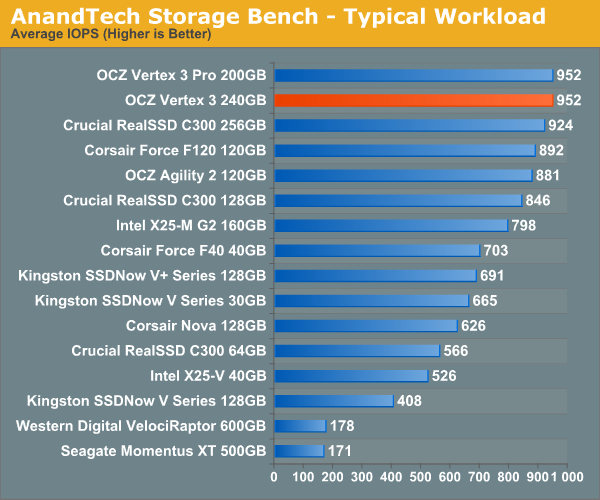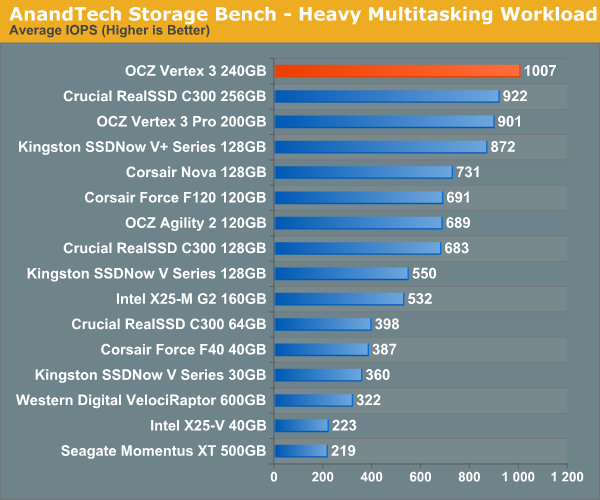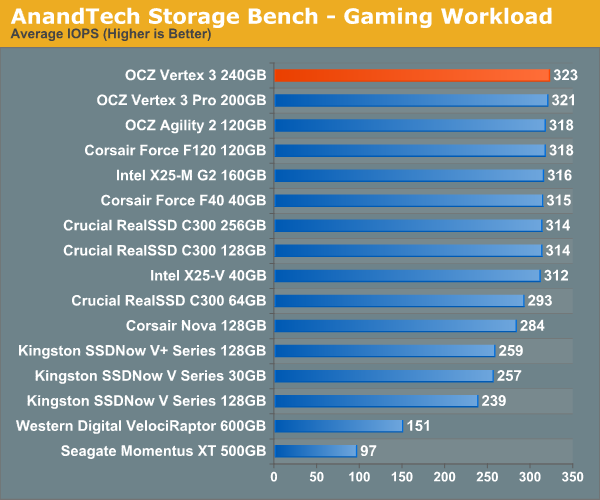OCZ Vertex 3 Preview: Faster and Cheaper than the Vertex 3 Pro
by Anand Lal Shimpi on February 24, 2011 9:02 AM ESTAnandTech Storage Bench 2010
To keep things consistent we've also included our older Storage Bench. Note that the old storage test system doesn't have a SATA 6Gbps controller, so we only have one result for the 6Gbps drives.
The first in our benchmark suite is a light/typical usage case. The Windows 7 system is loaded with Firefox, Office 2007 and Adobe Reader among other applications. With Firefox we browse web pages like Facebook, AnandTech, Digg and other sites. Outlook is also running and we use it to check emails, create and send a message with a PDF attachment. Adobe Reader is used to view some PDFs. Excel 2007 is used to create a spreadsheet, graphs and save the document. The same goes for Word 2007. We open and step through a presentation in PowerPoint 2007 received as an email attachment before saving it to the desktop. Finally we watch a bit of a Firefly episode in Windows Media Player 11.
There’s some level of multitasking going on here but it’s not unreasonable by any means. Generally the application tasks proceed linearly, with the exception of things like web browsing which may happen in between one of the other tasks.
The recording is played back on all of our drives here today. Remember that we’re isolating disk performance, all we’re doing is playing back every single disk access that happened in that ~5 minute period of usage. The light workload is composed of 37,501 reads and 20,268 writes. Over 30% of the IOs are 4KB, 11% are 16KB, 22% are 32KB and approximately 13% are 64KB in size. Less than 30% of the operations are absolutely sequential in nature. Average queue depth is 6.09 IOs.
The performance results are reported in average I/O Operations per Second (IOPS):

If there’s a light usage case there’s bound to be a heavy one. In this test we have Microsoft Security Essentials running in the background with real time virus scanning enabled. We also perform a quick scan in the middle of the test. Firefox, Outlook, Excel, Word and Powerpoint are all used the same as they were in the light test. We add Photoshop CS4 to the mix, opening a bunch of 12MP images, editing them, then saving them as highly compressed JPGs for web publishing. Windows 7’s picture viewer is used to view a bunch of pictures on the hard drive. We use 7-zip to create and extract .7z archives. Downloading is also prominently featured in our heavy test; we download large files from the Internet during portions of the benchmark, as well as use uTorrent to grab a couple of torrents. Some of the applications in use are installed during the benchmark, Windows updates are also installed. Towards the end of the test we launch World of Warcraft, play for a few minutes, then delete the folder. This test also takes into account all of the disk accesses that happen while the OS is booting.
The benchmark is 22 minutes long and it consists of 128,895 read operations and 72,411 write operations. Roughly 44% of all IOs were sequential. Approximately 30% of all accesses were 4KB in size, 12% were 16KB in size, 14% were 32KB and 20% were 64KB. Average queue depth was 3.59.

The gaming workload is made up of 75,206 read operations and only 4,592 write operations. Only 20% of the accesses are 4KB in size, nearly 40% are 64KB and 20% are 32KB. A whopping 69% of the IOs are sequential, meaning this is predominantly a sequential read benchmark. The average queue depth is 7.76 IOs.











85 Comments
View All Comments
Cow86 - Thursday, February 24, 2011 - link
This is likely going into my next build ^^ Which is a few months off still, so hopefully the prices will be somewhat favourable by then....vol7ron - Friday, February 25, 2011 - link
let me guess... waiting for z68? :)Rasterman - Thursday, February 24, 2011 - link
Which of the benchmarks relate to loading windows and loading programs and games or levels in games? It would be nice to see how these compare, my guess is its not worth it to upgrade from a Crucial Real SSD C300 256GB to a Vertex 3 256GB as the perceived difference is going to be negligible?Some real world tests would be nice:
fresh load of windows 7
start windows 7 from hibernation
starting major games
loading levels in major games
starting major programs (photoshop, visual studio, windows media player, itunes, outlook)
ImSpartacus - Thursday, February 24, 2011 - link
Well, if you do upgrade from that C300, I would happily take it off your hands.I figure that old hardware is only worth, ohhhh, $100? Yeah, that's about right.
So, what do you say?
Figaro56 - Friday, February 25, 2011 - link
The Crucial C300 256GB drive for $100? Dream on!You can buy one brand new today for $420 shipped at amazon.com. You under estimate the C300, it's still a valid product and $100 is just a ridiculous comment.
vol7ron - Friday, February 25, 2011 - link
brand new != usedwith a used drive, you've already cut into warranty and you've reduced its lifespan (as negligible a point as it may be).
Figaro56 - Friday, February 25, 2011 - link
Then you had better buy a new one then. No one is going to sell their originally priced $600 Crucial RealSSD C300 256GB SSD for $100, especially after this review.There is a margin of real world performance improvement with the Vertex 3 true, but certainly not so superior over the C300 as to make someone crazy enough to sell an 8 month old $600 SSD for $100 as it's "obviously" not obsolete it's just 2nd best. That's just retarded.
These SSD drives have an incredible life span so cutting into the life span over 8 months of use is nebulous. The warranty is only there for warm fuzzies, if it works it works.
jimhsu - Friday, February 25, 2011 - link
I suppose IM's response is a joke considering the OP's question of whether an ultra-fast drive is faster than the super-fast drive that he already has.(For the record, I bought the C300 256GB for $400 in newegg's awesome 20% off sale).
vol7ron - Friday, February 25, 2011 - link
I took it as a joke too, but still you're not going to get top dollar if you're selling a used device. A person would rather go get a refurb.Also, didn't the C300 have many problems that crept up? Not saying it hasn't been solved and the problems weren't rare, but I though a few weeks after Anand got their version, it died - and a few others died as well (betas and productions). For whatever reason, I decided to stay away from Crucial for that reason; not permanently, but in the short run.
I'm more curious to see with what Intel has to offer. Even if they don't introduce a compression algorithm, I like their wear-leveling better - it should require less additional spare NAND and be cheaper in general. And, of course, I like to see how Vertex 3 fares with TRIM as it approaches the capacity limit.
Figaro56 - Tuesday, March 1, 2011 - link
The infamous firmware issue of the Crucial drive was solved, I've never had a problem. This C300 is a very fast SSD and I'm more than happy with it. When an SSD comes along that is actually twice as fast in every bench mark as my C300 256GB SSD then I might feel as though it's obsolete, but we're not there yet.